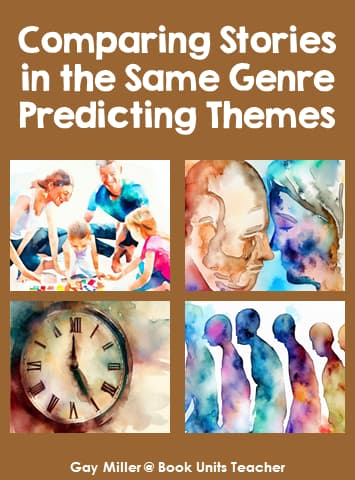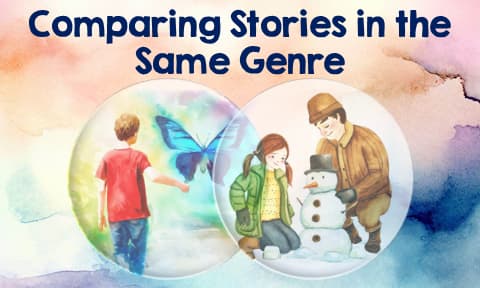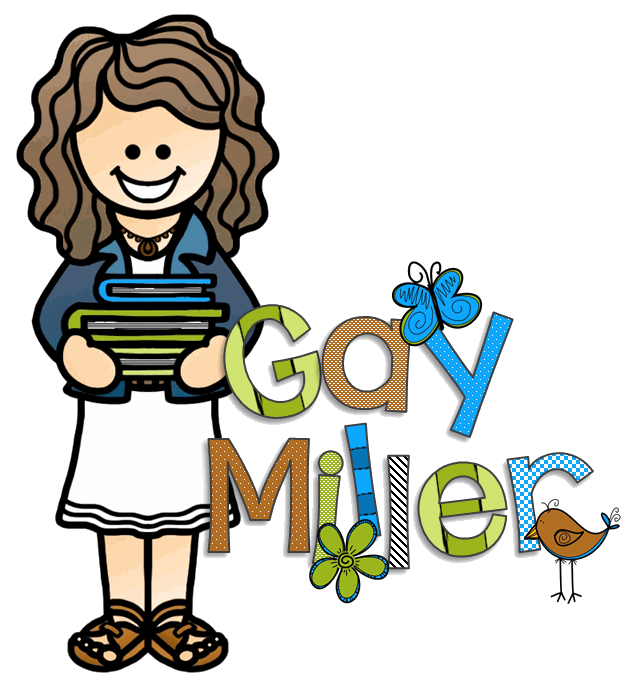
Welcome to part two of our Compare & Contrast reading series! (If you missed part one—comparing themes across cultures—go check it out!) This week, we’re zooming in on stories in the same genre and asking the question:
“If two books are both realistic fiction, why do they feel so different?”
You’ve likely heard a student say, “This book is just like the last one!”—but when pressed to explain why, they freeze up. This lesson will help students move from vague reactions to thoughtful comparisons based on theme, characters, setting, and structure.
📚 This lesson targets RL.5.9—comparing stories in the same genre—and it’s packed with engaging activities like animated short films and a watercolor-themed art project to bring those literary connections to life.
Get the full lesson plan here, including all the materials you’ll need! Because if there’s one thing teachers love, it’s a lesson plan that’s already done for them.
Comparing Stories in the Same Genre
✨ What Students Will Learn

This lesson helps students…
identify common elements across stories in the same genre
analyze how authors approach similar themes in different ways
use graphic organizers to compare and contrast story elements
express theme understanding through visual art
✨ Hook Activity: Predicting Themes

Kick things off with a series of watercolor images. Ask students to examine each and predict the theme that connects them.
Themes may include:
time
family
life and change
Have students discuss their observations, emotions, and interpretations—then lead them into a conversation about how these same themes appear across different stories (even within the same genre!).
✨ Activity #1: Organizer – Comparing and Contrasting Stories

Before diving into the films, lay a foundation with the video lesson. Students will…
learn key compare/contrast vocabulary
explore Venn diagrams and T-charts
use an organizer to capture essential terms and definitions
✨Activity #2: Analyzing Animated Shorts

Next up—short films! (Because let’s be honest—nothing captures attention like animation.)
Have students watch two animated shorts:
Life and Butterflies – a reflective piece on time and joy
Snowball – a whimsical story with themes of family and resilience
Students complete a summarizing T-chart for each short, capturing:
characters
setting
conflict
theme
Then, they’ll use guiding questions to compare and contrast the two.
Video Lesson

Life and Butterflies Animated Short

Snowball Animated Short
✨Activity #3: Creative Expression
To wrap it all up with creativity, students will paint watercolor backgrounds in soft washes of color. On top, they’ll write a meaningful quote that connects to one of the themes from the shorts.
Encourage them to choose quotes about:
time
family
life’s journey
You’ll be amazed how much literary understanding they can express with a brush and a Sharpie!

Give students cards with excerpts from well-known novels in different genres. Some of the novels I use are:
- Harry Potter and the Sorcerer’s Stone by J.K. Rowling (fantasy)
- The Hunger Games by Suzanne Collins (science fiction)
- The Diary of a Young Girl by Anne Frank (historical fiction)
- Holes by Gary Louis Sachar (adventure)
- The Outsiders by S.E. Hinton (realistic fiction )
- The Road Not Taken by Robert Frost (poetry)
Wrap-Up: What They’ll Take Away
By the end of this lesson, students will:
recognize common threads in genre-based stories
understand how authors handle theme in different ways
express their interpretations both analytically and creatively
build confidence in literary discussion and comparison
This is a great opening lesson for teaching RL.5.9 and sets the stage for deeper genre studies.
Grab the lesson handout here so you’re ready to roll with the organizer, discussion questions, and materials.
Want More Reading Skill Practice?
Build a strong foundation in comprehension with my Reading Skills Bundle. It includes 12 complete units covering:
- Text Structure
- Story Elements
- Main Idea & Details
- Cause & Effect
- Compare & Contrast
- Inference
- And more!
Each unit comes with printables, graphic organizers, and engaging activities that make reading skills stick.
See all three posts in this series.



